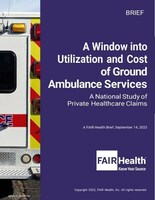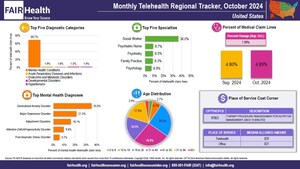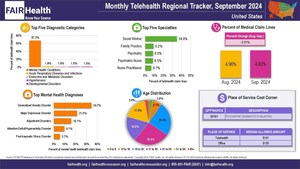Nearly 60 Percent of Ground Ambulance Rides Were Out of Network in 2022, according to New FAIR Health Study
From 2018 to 2022, 52 Percent of Male Patients Aged 65 and Older Were Admitted to A Hospital after Ground Ambulance Transport
States in West and Midwest Saw Highest Average Allowed Amounts for Ground Ambulance Mileage
NEW YORK, Sept. 14, 2023 /PRNewswire/ -- Out-of-network ground ambulance rides accounted for a larger percentage of ground ambulance claim lines1 than in-network rides from 2018 to 2022. In 2022, out-of-network transport accounted for 59.4 percent of all ground ambulance claim lines, while in-network transports made up 40.6 percent of the distribution. There was a slight decrease in out-of-network transports during this period: Out-of-network rides made up 63.7 percent of all ground ambulance claim lines in 2018 compared to 59.4 percent in 2022. In addition, individuals aged 65 and older experienced higher rates of ground ambulance rides resulting in inpatient admission than any other age group in the period 2018-2022; 52.0 percent of male patients and 47.9 percent of female patients in that age group were admitted to a hospital after ground ambulance transport. These and other findings are reported in a FAIR Health brief released today, A Window into Utilization and Cost of Ground Ambulance Services: A National Study of Private Healthcare Claims.
FAIR Health drew on its repository of billions of private healthcare claims to shed light on both emergency and nonemergency ground ambulance services across the nation in the period 2018 to 2022. The report examines utilization, cost, age and gender, diagnosis, differences across states and outcomes associated with ground ambulance transport (e.g., inpatient admission). Among the key findings:
- Throughout the period 2018-2022, advanced life support (ALS) services, which can provide a higher level of care than basic life support (BLS) services, accounted for a slightly larger percentage of ground ambulance claim lines than BLS services. For example, in 2022, 51.1 percent of ground ambulance claim lines were associated with ALS compared to 48.9 percent associated with BLS.
- Emergency transport was more common than nonemergency transport for both ALS and BLS ground ambulance services from 2018 to 2022.
- In 2022, average allowed amounts2 were consistently higher for ALS ground ambulance services than for BLS services, though costs varied by state.
- Individuals 65 years and older were the largest age group associated with both ALS and BLS ground ambulance services among the commercially insured and Medicare Advantage population, though their share of ALS ground ambulance claim lines decreased from 37.4 percent in 2018 to 30.6 percent in 2022 and their share of BLS ground ambulance claim lines decreased from 47.5 percent to 40.9 percent in 2022.
- In addition to being used for transport, ground ambulances can provide on-site treatment, without transporting the patient from the original location to a hospital.3 Such treatment increased from 2018 to 2020, rising from 1.4 percent to 2.0 percent of all ground ambulance claim lines, but decreased slightly in the following years, dropping to 1.9 percent by 2022.
- From 2018 to 2022, response and treatment without transport accounted for a higher percentage of ground ambulance claim lines among individuals aged 19 to 35 than any other age group: between 2.2 and 3.1 percent. By comparison, the age cohort 65 years and older had the lowest percentage.
- General signs and symptoms were the most common diagnosis associated with the various ground ambulance types (ALS, BLS and response and treatment—no transport) evaluated from 2018 to 2022.
- General signs and symptoms involving circulatory and respiratory systems were the second most common reason for ground ambulance services among the top diagnoses for ALS services, non-transport services and all services involving transport (i.e., excluding no transport).
- Mental health conditions accounted for the third largest share of BLS ground ambulance claim lines; this diagnosis was eighth on the lists for ALS services and all services involving transport, and sixth on the list for response and treatment—no transport services.
- From 2018 through 2022, the five states with the highest average mileage for ground ambulance transport were Vermont (33.8 miles), Maine (30.6 miles), Wyoming (25.0 miles), North Dakota (24.6 miles) and Mississippi (23.8 miles). The jurisdictions with the lowest average ground ambulance mileage were Washington, DC (7.9 miles); Alaska (8.8 miles); New York (9.1 miles); Nevada (9.4 miles); and Massachusetts (9.9 miles).
- The five states with the highest average allowed (in-network) amounts for ground ambulance mileage per statute mile in 2022 were Utah ($28.35), Wyoming ($24.29), California ($20.63), North Dakota ($19.36) and Nevada ($18.76). The lowest average allowed amounts for ground ambulance mileage per statute mile in 2022 occurred in Florida ($5.79), Maine ($7.55), North Carolina ($7.66), Vermont ($7.71) and Maryland ($8.21).
- From 2018 to 2022, out-of-network ground ambulance rides accounted for a larger percentage of total ground ambulance claim lines than in-network rides, though there was a slight decrease in out-of-network services during this period. Out-of-network rides made up 63.7 percent of all ground ambulance claim lines in 2018 and 59.4 percent in 2022.
- For nonemergency ground ambulance services, the percentage of in-network versus out-of-network nonemergency ground ambulance services was fairly even from 2018 to 2022. In-network rides accounted for 48.6 percent to 51.3 percent of nonemergency ground ambulance claim lines during this period and out-of-network rides made up 48.7 percent to 51.4 percent.
- Emergency ground ambulance services were more frequently rendered out of network than in network, though the percentage of out-of-network rides declined from 2018 to 2022. In 2018, out-of-network services accounted for 68.3 percent of emergency ground ambulance claim lines, but by 2022, their share of the distribution decreased to 62.0 percent.
- Both males and females aged 65 and older experienced higher rates of ground ambulance rides resulting in inpatient admission than any other age group in the period 2018-2022; 52.0 percent of male patients and 47.9 percent of female patients in that age group were admitted to a hospital after ground ambulance transport.
FAIR Health President Robin Gelburd stated: "Ground ambulance services have been the subject of substantial policy interest. We hope that this study of ground ambulance transport proves useful to policy makers, researchers, payors, providers and consumers seeking to better understand this component of the healthcare system."
For the new brief, click here.
About FAIR Health
FAIR Health is a national, independent nonprofit organization that qualifies as a public charity under section 501(c)(3) of the federal tax code. It is dedicated to bringing transparency to healthcare costs and health insurance information through data products, consumer resources and health systems research support. FAIR Health possesses the nation's largest collection of private healthcare claims data, which includes over 42 billion claim records and is growing at a rate of over 2 billion claim records a year. FAIR Health licenses its privately billed data and data products—including benchmark modules, data visualizations, custom analytics and market indices—to commercial insurers and self-insurers, employers, providers, hospitals and healthcare systems, government agencies, researchers and others. Certified by the Centers for Medicare & Medicaid Services (CMS) as a national Qualified Entity, FAIR Health also receives data representing the experience of all individuals enrolled in traditional Medicare Parts A, B and D; FAIR Health includes among the private claims data in its database, data on Medicare Advantage enrollees. FAIR Health can produce insightful analytic reports and data products based on combined Medicare and commercial claims data for government, providers, payors and other authorized users. FAIR Health's systems for processing and storing protected health information have earned HITRUST CSF certification and achieved AICPA SOC 2 Type 2 compliance by meeting the rigorous data security requirements of these standards. As a testament to the reliability and objectivity of FAIR Health data, the data have been incorporated in statutes and regulations around the country and designated as the official, neutral data source for a variety of state health programs, including workers' compensation and personal injury protection (PIP) programs. FAIR Health data serve as an official reference point in support of certain state balance billing laws that protect consumers against bills for surprise out-of-network and emergency services. FAIR Health also uses its database to power a free consumer website available in English and Spanish, which enables consumers to estimate and plan for their healthcare expenditures and offers a rich educational platform on health insurance. An English/Spanish mobile app offers the same educational platform in a concise format and links to the cost estimation tools. The website has been honored by the White House Summit on Smart Disclosure, the Agency for Healthcare Research and Quality (AHRQ), URAC, the eHealthcare Leadership Awards, appPicker, Employee Benefit News and Kiplinger's Personal Finance. FAIR Health also is named a top resource for patients in Dr. Elisabeth Rosenthal's book An American Sickness: How Healthcare Became Big Business and How You Can Take It Back. For more information on FAIR Health, visit fairhealth.org.
Contact:
Rachel Kent
Senior Director of Communications and Marketing
FAIR Health
646-396-0795
[email protected]
1 "Claim lines" are the individual procedures or services listed on an insurance claim.
2 An allowed amount is the total fee negotiated between an insurance plan and a provider for an in-network service; the allowed amount includes both the insurer's and the member's share of the total fee.
3 For example, on-site treatment may be provided when the patient refuses to be transported to a hospital.
SOURCE FAIR Health

WANT YOUR COMPANY'S NEWS FEATURED ON PRNEWSWIRE.COM?
Newsrooms &
Influencers
Digital Media
Outlets
Journalists
Opted In







Share this article